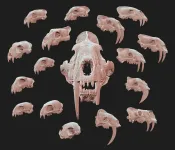(Press-News.org) · One region is related to olfaction and reward, the other to negative feelings like pain · When the connection between these brain regions is weak, people have higher BMI
· Food may continue to be rewarding, even when these individuals are full
CHICAGO --- Why can some people easily stop eating when they are full and others can’t, which can lead to obesity?
A Northwestern Medicine study has found one reason may be a newly discovered structural connection between two regions in the brain that appears to be involved in regulating feeding behavior. These regions involve the sense of smell and behavior motivation.
The weaker the connection between these two brain regions, the higher a person’s Body Mass Index (BMI), the Northwestern scientists report.
The investigators discovered this connection between the olfactory tubercle, an olfactory cortical region, which is part of the brain’s reward system, and a midbrain region called the periaqueductal gray (PAG), involved in motivated behavior in response to negative feelings like pain and threat and potentially in suppression of eating.
The study will be published May 16 in the Journal of Neuroscience.
Previous research at Northwestern by co-author Thorsten Kahnt, now at the National Institutes of Health, has shown the smell of food is appetizing when you’re hungry. But the smell is less appealing when you eat that food until you are full.
Odors play an important role in guiding motivated behaviors such as food intake, and— in turn — olfactory perception is modulated by how hungry we are.
Scientists have not fully understood the neural underpinnings of how the sense of smell contributes to how much we eat.
“The desire to eat is related to how appealing the smell of food is — food smells better when you are hungry than when you are full,” said corresponding author Guangyu Zhou, research assistant professor of neurology at Northwestern University Feinberg School of Medicine. “But if the brain circuits that help guide this behavior are disrupted, these signals may get confused, leading to food being rewarding even when you are full. If this happens, a person’s BMI could increase. And that is what we found. When the structural connection between these two brain regions is weaker, a person’s BMI is higher, on average.”
Though this study does not directly show it, the study authors hypothesize that healthy brain networks connecting reward areas with behavior areas could regulate eating behavior by sending messages telling the individual that eating doesn’t feel good anymore when they’re full. In fact, it feels bad to overeat. It’s like a switch in the brain that turns off the desire to eat.
But people with weak or disrupted circuits connecting these areas may not get these stop signals, and may keep eating even when they aren’t hungry, the scientists said.
“Understanding how these basic processes work in the brain is an important prerequisite to future work that can lead to treatments for overeating,” said senior author Christina Zelano, associate professor of neurology at Feinberg.
How the study worked
This study used MRI brain data — neurological imaging — from the Human Connectome Project, a large multi-center NIH project designed to build a network map of the human brain.
Northwestern’s Zhou found correlations to BMI in the circuit between the olfactory tubercle and the midbrain region, the periaqueductal gray. For the first time in humans, Zhou also mapped the strength of the circuit across the olfactory tubercle, then replicated these findings in a smaller MRI brain dataset that scientists collected in their lab at Northwestern.
“Future studies will be needed to uncover the exact mechanisms in the brain that regulate eating behavior,” Zelano said.
The research reported in this press release was supported by the National Institute on Deafness and Other Communication Diseases grants R01-DC-016364, R01-DC-018539, R01-DC-015426 and the Intramural Research Program at the National Institute on Drug Abuse grant ZIA DA000642, all of the National Institutes of Health. The content is solely the responsibility of the authors and does not necessarily represent the official views of the National Institutes of Health.
END
Unique brain circuit is linked to Body Mass Index
Newly discovered connection between two brain regions may help regulate how much we eat
2024-05-16
ELSE PRESS RELEASES FROM THIS DATE:
Noise survey highlights need for new direction at Canadian airports #ASA186
2024-05-16
OTTAWA, Ontario, May 16, 2024 – The COVID-19 pandemic changed life in many ways, including stopping nearly all commercial flights. At the Toronto Pearson International Airport, airplane traffic dropped by 80% in the first few months of lockdown. For a nearby group of researchers, this presented a unique opportunity.
Julia Jovanovic will present the results of a survey conducted on aircraft noise and annoyance during the pandemic era Thursday, May 16, at 11:10 a.m. EDT as part of a joint meeting of the Acoustical Society of America and ...
COSPAR partners with LASP for 1st COSPAR Center of Excellence
2024-05-16
Partnering with LASP was an obvious decision for COSPAR. LASP stands out with its distinguished track record in space science research, having deployed scientific instruments to every planet in our solar system, the Sun and numerous moons. In particular, LASP has been at the forefront of pioneering Cube-Sat missions, consistently achieving remarkable success in gathering scientific data. With seven completed CubeSat missions and nine more in active development or orbit, LASP has demonstrated unparalleled expertise in this field. ...
Building a better sarcasm detector #ASA186
2024-05-16
OTTAWA, Ontario, May 16, 2024 – Oscar Wilde once said that sarcasm was the lowest form of wit, but the highest form of intelligence. Perhaps that is due to how difficult it is to use and understand. Sarcasm is notoriously tricky to convey through text — even in person, it can be easily misinterpreted. The subtle changes in tone that convey sarcasm often confuse computer algorithms as well, limiting virtual assistants and content analysis tools.
Xiyuan Gao, Shekhar Nayak, and Matt Coler of Speech Technology Lab at the University of Groningen, Campus Fryslân developed a multimodal algorithm ...
Natural toxins in food: Many people are not aware of the health risks
2024-05-16
Many people are concerned about residues of chemicals, contaminants or microplastics in their food. However, it is less well known that many foods also contain toxins of completely natural origin. These are often chemical compounds that plants use to ward off predators such as insects or microorganisms. These substances are found in beans and potatoes, for example, and can pose potential health risks. However, according to a recent representative survey by the German Federal Institute for Risk Assessment (BfR), only just under half of the respondents (47 per cent) were even aware of plant toxic substances. The BfR Consumer Monitor Special on naturally occurring plant toxins ...
Archaeology: Egyptian pyramids built along long-lost Ahramat branch of the Nile
2024-05-16
31 pyramids in Egypt, including the Giza pyramid complex, may originally have been built along a 64-km-long branch of the river Nile which has long since been buried beneath farmland and desert. The findings, reported in a paper in Communications Earth & Environment, could explain why these pyramids are concentrated in what is now a narrow, inhospitable desert strip.
The Egyptian pyramid fields between Giza and Lisht, built over a nearly 1,000-year period starting approximately 4,700 years ago, now sit on the edge of the inhospitable Western Desert, part of the Sahara. ...
Effectiveness of a web-based cognitive behavioral self-help intervention for binge eating disorder
2024-05-16
About The Study: In this randomized clinical trial of a web-based self-help intervention for patients with binge eating disorder, the findings confirmed its effectiveness in reducing binge eating episodes and improving various mental health outcomes, highlighting a scalable solution to bridge the treatment gap for this condition.
Corresponding Author: To contact the corresponding author, Luise Pruessner, M.S., email luise.pruessner@psychologie.uni-heidelberg.de.
To access the embargoed study: Visit our For The Media website at this link ...
Physician and AI chatbot responses to cancer questions from social media
2024-05-16
About The Study: The findings of this study suggest that chatbots can generate quality, empathetic, and readable responses to patient questions comparable to physician responses sourced from an online forum. Further research is required to assess the scope, process integration, and patient and physician outcomes of chatbot-facilitated interactions.
Corresponding Author: To contact the corresponding author, Srinivas Raman, M.D., M.A.Sc., email srinivas.raman@rmp.uhn.ca.
To access the embargoed study: Visit ...
How did sabre-toothed tigers acquire their long upper canine teeth?
2024-05-16
In a groundbreaking study, an international team led by scientists from the University of Liège has investigated the evolutionary patterns behind the development of sabre teeth, with some unexpected results along the way. A study that enriches our understanding of the Earth's past, but also documents the mechanisms leading to evolutionary convergence.
Sabre teeth, those iconic elongated upper canine teeth, have long fascinated both scientists and the general public, notably because they have appeared several times in the fossil record, including two particularly well-known lineages of sabre-toothed tigers: the felids (the family of ...
End-of-life systemic treatment for patients with advanced cancers does not improve survival
2024-05-16
Patients with very advanced solid tumors saw no significant improvement in overall survival after receiving systemic therapy, according to a study published today in JAMA Oncology by researchers at The University of Texas MD Anderson Cancer Center and Yale Cancer Center.
The findings provide further evidence to help oncologists counsel patients that additional cancer-directed therapy is not likely to benefit them, allowing them to focus instead on palliative and supportive care options that have been demonstrated ...
To optimize guide-dog robots, first listen to the visually impaired
2024-05-16
May 16, 2024
To Optimize Guide-Dog Robots, First Listen to the Visually Impaired
Award-winning research led by UMass Amherst shows to be successful, Guide-dog users and trainers need to provide insight into features that make robotic helpers useful in the real world
AMHERST, Mass. — What features does a robotic guide dog need? Ask the blind, say the authors of an award-winning paper. Led by researchers at the University of Massachusetts Amherst, a study identifying how to develop robot guide dogs with insights from guide dog users and trainers won a Best Paper Award at ...
LAST 30 PRESS RELEASES:
School meals could unlock major gains for human and planetary health
Menopause hormone therapy does not appear to impact dementia risk
Signature patterns of brain activity may help predict recovery from traumatic brain injury
Dresden study uncovers new key mechanism in cancer cells
New species are now being discovered faster than ever before, study suggests
Cannabis-based products show limited short-term benefit for chronic pain, with increased risk of adverse effects
Cannabis products with more THC slightly reduce pain but cause more side effects
Clearing the brain of aging cells could aid epilepsy and reduce seizures
Brain injuries linked with potential risk of suicide, new study finds
New technique lights up where drugs go in the body, cell by cell
New study finds movement of fishing fleets can reveal shifts in marine ecosystems
Embargoed: New evidence points to potential treatment for vascular dementia
Study uncovers disrupted brain balance in alcohol dependence
Working in groups can help Republicans and Democrats agree on controversial content moderation online
Structural findings reveal how distinct GPCR ligands create different levels of activation
Anything-goes “anyons” may be at the root of surprising quantum experiments
UC review: Maximizing workplace opportunity for veterans
From generation to complex control: Metasurfaces make perfect vortex beams "within reach"
Thin-film lithium niobate-based detector: recent advances and perspectives
Exploring why some people may tend to persistently make bad choices
How cells balance their protein levels
Nirsevimab vs RSVpreF vaccine for RSV–related hospitalization in newborns
Effectiveness and impact of maternal RSV immunization and nirsevimab on medically attended RSV in US children
AI gives scientists a boost, but at the cost of too many mediocre papers
Next-generation vision model maps tree growth at sub-meter precision
Genes aren’t destiny for inherited blindness, study shows
MIT study: High-fat diets make liver cells more likely to become cancerous
Exposure to multiple fine particulate matter components and incident depression in the US Medicare population
Risk of burdensome health care spending over time in the US
Nirsevimab against hospitalizations and emergency department visits for lower respiratory tract infection in infants
[Press-News.org] Unique brain circuit is linked to Body Mass IndexNewly discovered connection between two brain regions may help regulate how much we eat



